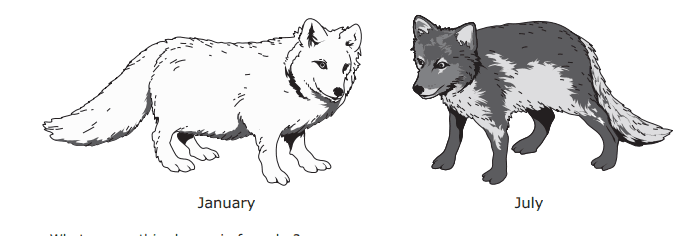
TEKS Biology High School - B.6.D: Gene Expression
Quiz by TEKS Biology High School
High School - Biology
Science (2010) (Archived)
Texas Essential Knowledge and Skills (TEKS)
Feel free to use or edit a copy
includes Teacher and Student dashboards
Track each student's skills and progress in your Mastery dashboards
With a free account, teachers can
- edit the questions
- save a copy for later
- start a class game
- automatically assign follow-up activities based on students’ scores
- assign as homework
- share a link with colleagues
- print as a bubble sheet
5 questions
Show answers
- Q1The arctic fox inhabits northern areas of North America. The same arctic fox is shown in the drawing at different times of the year. What causes this change in fur color?The arctic fox has two traits for fur color that are determined at birthGene expression for fur color is regulated by temperatureGene expression for fur color is regulated by latitudeThe alleles for fur color change as the arctic fox grows older30sB.6.D: Gene Expression
- Q2Human bone, muscle, and nerve cells all contain the same number of chromosomes with the same complement of genes. What enables these cells to perform specialized activities?The mutation of genes within each cell typeThe ability of some cells to remove unnecessary DNA sequencesThe use of different methods of cell divisionThe regulation of gene expression within each cell type30sB.6.D: Gene Expression
- Q3At birth Himalayan rabbits are usually white over their entire bodies. But when parts of their bodies reach temperatures below 35°C, a pigment that causes these parts to turn black is produced. Which of the following is most likely the cause of this phenomenon?Gene expression that is regulated by temperatureInfection caused by cold temperaturesA trait that is both sex-linked and hormone-dependentPoor blood circulation30sB.6.D: Gene Expression
- Q4In 1917 the biologist Thomas Hunt Morgan conducted studies in which he kept some caterpillars in the dark and placed some others under red, green, or blue lights. Exposure to red light produced butterflies with brightly colored wings. Exposure to green light resulted in dark-colored wings. Exposure to blue light or no light resulted in pale-colored wings. What was the most likely conclusion of Morgan’s research?Caterpillars exposed to red and green light are healthier than caterpillars exposed to no light or blue lightThe genes regulating wing color in butterflies are influenced by environmental factorsThe pigment in butterfly wings absorbs light from the environmentThe phenotypic expression of wing shape depends on color pigmentation in butterflies30sB.6.D: Gene Expression
- Q5The Himalayan rabbit's habitat has cold, snowy winters and mild summers. The body is typically covered in white fur except for the nose, feet, tail, and ears, which are covered in black fur. A scientist shaved an area of white fur on the back of a Himalayan rabbit and placed an ice pack over the shaved area. The shaved area grew black fur. Which of these best explains why the hair that grew back where the ice pack was placed was black and not white?White hair only grows during certain times of the year.The white hair mutated to black hair as the rabbit's body temperature decreased.The coat color changed from white to black with the age of the rabbit.The genes for black hair were activated by specific temperatures.The white hair mutated to black hair as the rabbit's body temperature decreased.60sB.6.D: Gene Expression
